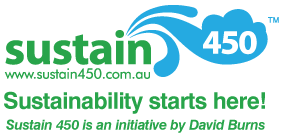
Welcome
David Burns is an environmental chemist with expertise in laboratory data audits, green chemistry, and industrial ecology. David is available to help business & professionals integrate sustainable supply chains and energy efficiency into service offerings. The following blog topics are intended to invoke awareness and/ or action in Going-Green. You are also invited to create a Free Whoisgreen business profile using the link above. David Burns is a NSC member of the Rocky Mountain Institute.

1. What is the ETS and should I support it?
The ETS stands for the Emissions Trading Scheme and is an economic mechanism that provides a FRAMEWORK to align global activities to limit carbon emissions in the atmosphere to safe levels by 2050. Many international governments are developing, adopting, or are in the process of implementing variations of an ETS. To date, governments have tended to show preference towards policies that rely upon a Cap & Trade system where there are incentives to encourage effective change. The Intergovernmental Panel of Climate Change (IPCC) scientists and leading economists say we need to take action NOW to manage the RISK that may effect our lifestyles in the coming years.
- The ETS was originally proposed by the Howard Liberal Government as a key policy for the Nov-2007 election.
- The alternative is a Carbon Tax.
Post Copenhagen: Governments have agreed in principle to a carbon inventory mechanism & open-process to manage climate temperature increases.
The ETS offers business a framework that allows management and consummers to respond without government regulation and control over spending, saving, and consumption. This basic framework provides a market driven price to be set on carbon for the first 12 months once an ETS is established, then allowing the market to determine the price. Businesses that invest in energy efficiency & resource productivity can trade their credits to other businesses that have not made an investment in these two areas.
Businesses that spend CAPEX on energy efficiency & resource productivity solutions are expected to benefit from reduced OPEX (operating expenses) and cleaner/ safer working conditions. This also means cheaper prices via competition at the cash register, and safer products. However, to pay for this transition, governments must adopt an economic mechanism that aportions the cost equitably across the community to pay for the required retrofits and re-tooling measures. The Government has announced assistance packages to support the vulnerable, and permits for large economically exposed emmitters to allow time to transition and not be disadvantaged.
Whether governments and businesses decide to choose an ETS or Carbon Tax, the response must address the need for industry and consummers to become radically increase energy efficiency and resource productivity. An interesting point to mention is that the actions required to address climate change are the same required to address energy efficiency and resource productivity increases. The only difference is who is responsible to pay for the change control mechanisms - always the consumer?
To learn and read more ... see what Ross Gittins (Sydney Morning Herald's Economics Editor) is saying -
#1 : Rudd's scheme unfair but effective - by Ross Gittins, dated 28-29 Nov 2009.
#2 : Clear air needed on emmissions - by Ross Gittins, dated 2 Dec 2009.
#3 : Abbott can't escape climate change and taxes - by Ross Gittins, dated 7 Dec 2009.
2. What can I do to become sustainable?
There are 7 Steps of Sustainable Action for individuals in the home & workplace (SME) to consider. These are:
- Landscapes that reflect natural environments with generous planting of native flora.
- Eco-effective homes & workplaces that conserve space, water, electricity, & gas via uptake of efficient solutions & behavioural change, and the harnessing of sunlight, rain & breeze. Elimination of waste & reuse of materials. Green homes and workplaces shall become locales that we enjoy to occupy with family & friends.
- Grid-connect photovoltaic solar energy from the sun able to power homes & business.
- Fuel efficient cars capable of <5L/100km, emit <120g CO2/km, and halve travel. Zero emission cars and fuel efficient trucks by 2015.
- Communities that encourage people to walk, ride, and use local transport when travelling to work or supporting local shops & markets.
- Businesses that integrate identities with community values and support local cultures.Distributed energy & water supplies within cities which are scalable to changing demographics.
- Conversion to a Service Economy by commercialising services based upon long-lasting products that are amenable to recycling in closed-loop material flows.
Benefits: clean air, healthy rivers, productive soils, diverse flora & fauna, and vibrant cities.
3. Does energy efficiency form part of sustainability?
Yes, Energy Efficiency is regarded as one of the most important aspects of sustainability and will ensure that governments can transition budgets away from new power plants into other areas such as health and education, and to fund social programes for the disadvantaged. However, individuals in the home & workplace (SME) need to take strong steps to reduce energy waste and purchase products that are designed to perform much better and use much less energy.
4. Are there specific things that businesses can do to become sustainable?
Leading businesses are finding new ways of doing things that produce better financial results, use less raw materials, use less water and electricity, and attract a higher calibre of staff and customer. Many design & engineering solutions are now being found in the new discipline of biomimicry. A great place to start is to identify business waste, and areas of water and electricty efficiency can be considered. Further positive change can be found by considering the following:
- Resource-productivity gains.
- Whole system optimisation/ least cost analysis at the design stage or during a planned retrofit which is applicable to buildings, transportation, industrial processes, agriculture, and electricity generation.
- Development of a sustainable workforce that has the confidence to move forward.
5. Where do I start?
Start by forming a framework based upon your values and principles that you feel happy to assign your name with, and which form the foundation of your beliefs. A good place to start is to write down your feelings about the following:
1) water
2) energy
3) home design
4) building materials
5) landscaping/ biodiversity
6) household/ business waste
Once you set your values, it is easy to write a list of actions to implement and move towards your sustainability goals. A sustainability plan can be a simple way of living in the home, or form part of a formal business plan that can begin with energy efficiency, elimination of waste, retrofits, and engaging people.
6. How long will it take me to make my home sustainable?
Sustainability in the home can begin immediately with a few behavioural changes such as switching off unused power points, and not wasting water, all of which will save you money. If you are designing a new home, start by planning prior to the build or renovation and ensure that your plan is followed. My home was completed in 14 months, and our lifestyle transformation has taken approximately another 3 years. After our home was completed, we started by planting a native garden, then choosing to purchase environmentally friendly products and services, and finally trading in my old gas guzzling ute for a new micro car (Smart for Two).
7. How long will it take my business to become sustainable?
It depends on the scale. The key is to start and do what you can now. Many organisations have unrealistic intensions of becoming carbon neutral within a single year. This is just not plausable! A great example is Ray Anderson who founded Interface, a global carpet tile company with an annual turnover of US $1.2B (Interface is listed on the New York stock exchange). Ray Anderon became aware of their environmental impact in 1994 after a customer questioned Interface's commitment to the environment. After reading Paul Hawkin's book "The Ecology of Commerce", Interface began researching how they could become great corporate and social champions in an industry that was traditionally regarded as an environmental villian. In 1996, Interface began their "Mission Zero" campaign to improve their environmental record and to stregthen the companies bottom line by setting an ambitious target of having a zero impact on nature by 2020. By 2009, the companies record read as follows:
1) greenhouse gas emissions cut by 82%
2) fossil fuel consumption cut by 60%
3) industrial waste cut by 66%
4) water consumption cut by 75%
5) factory smokestacks (global) reduced from 247 to 160 by divesture, than 107 via technology improvements
6) factory wastewater effluent pipes (global) reduced from 19 to 2
7) sales increased by 66%
8) earnings doubled
9) profit margins raised
10) patents of new machines & materials.
As you can see, this example demonstates the importance of starting now and following a long term plan. Ray Anderson of interface says that they are 75% of the way to reaching their Mission Zero target.
The key is to start and measure your activity on a regular basis until you reach your long-term target.
8. Can I offset the cost of solar photvoltaics and water tanks by eliminating air conditioning?
Yes. My personal experience when building our sustainable home demonstrates that good planning and passive solar design can allow you to eliminate air conditioning. Many ducted air conditioning systems for multilevel homes are priced between $30K - $60K. Homes that are designed with wide eaves, engineered windows or window films, and use the wind to suck out hot internal air are examples of how to naturally cool your home. Homes that can be heated with the suns energy by capturing solar thermal heat from the roof and then distributing the heat during winter via wall mounted radiators and hydronic floor heating are examples of passive heating. The money saved can be used to purchase a 20K litre water harvesting system, and a 2-4kW grid connected photovoltaic solar power system. In NSW, from 1 February 2010, each electricity utility will be required to pay a gross feed-in-tarrif of $0.60 per KW, which accounts to a cheque received from your utility instead of paying them to consume electricity.
9. Commercial examples
The Empire State Building will begin a massive energy efficiency retrofit beginning mid 2010. Every glass window in the building will be removed and doubled glazed at ground level and reinstalled at a cost of US$13 million. The new super-window retrofit is expected to provide a 38% energy saving, with a three year payback". The managing agent, Jones Lang LaSalle expects that commercial buildings that have lower opperating costs will attract a higher calibre of tenant willing to sign longer lease agreements.
10. How much will it cost?
Sustain450 provides advice for home owners and business (SME), and assists with choices in a market changing rapidly.Our fees are based on a standard consultantancy arrangement as follows:
1) Full-day home building orientation (includes tour of sustainable home, reading material and video) - $500.00.
2) Selection of achitect - $250.00
3) Business assessment, sustainability plan, and implementation - $155.00/ hour.
All rates are in AUD$ and exclusive of GST where applicable.
11. What does Sustain450 mean?
Governments acknowledge that carbon emissions must be reduced by approximately 80% in todays terms if concentrations in the atmosphere are to be kept within the perceived safe level of 450 parts per million by 2050. The Intergovernmental Panel of Climate Change (IPCC) scientists believe that the safe level of carbon dioxide is 350 parts per million. The current carbon dioxide concentration is 387 parts per million (March 2009).
It is obvious that whoever is right, that both mitigation and adaptation measures are required to address the challenges that climate change will present. The key mechanism available to all governements shall be energy efficiency and elimination of waste.
12. What is Sustainability?
It is a healthy relationship between people, communities, and the environment, over the long term underpinned by ethical economic conditions. A healthy and balanced society is only possible if respect and value of natural capital (environment) exisits.
13. What is Eco-Effectiveness?
It is a process initiated through values that inspire creative designs that capture natural energy flows that are cost effective, high performing and benefit local communities. Eco-effective processes typically reduce ongoing regulation and upkeep.

